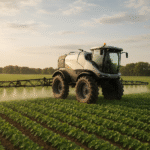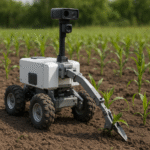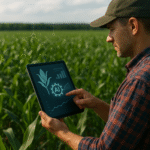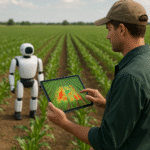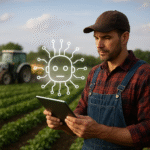In modern agriculture, the convergence of advanced technologies is reshaping how farmers choose the right crops for each field. AI-Powered Crop Recommendation Systems harness vast amounts of data and sophisticated models to provide tailored advice that optimizes both resource use and harvest outcomes. This article explores the transformative potential of these systems within the realm of impressive agriculture, highlighting key processes, technological integrations, and future directions.
Revolutionizing Crop Selection with AI
Traditional crop selection often relies on historical knowledge, experience, and rudimentary soil tests. However, leveraging AI introduces a dynamic, data-driven approach that adapts to changing environmental conditions and market trends. By analyzing massive datasets, AI models can predict which crop varieties will thrive, thereby enhancing farm-level decision-making.
Core Components of Recommendation Engines
- Machine learning models trained on historical yield data, weather patterns, and soil attributes.
- Algorithms that incorporate remote sensing and satellite imagery for up-to-date field conditions.
- Integration with mobile and cloud-based platforms for real-time guidance.
How It Works
Crop recommendation systems typically follow a multi-step workflow:
- Data Collection: Farmers upload or synchronize sensor data, local weather records, and past cropping history.
- Preprocessing: Raw data is cleaned, normalized, and enriched with external sources such as market price indexes.
- Model Training: Advanced neural networks and decision-tree ensembles learn patterns between inputs (soil pH, moisture, nutrient levels) and outputs (yield, disease incidence).
- Recommendation Generation: The system suggests optimal crop varieties, planting dates, and field management practices customized to each plot.
By combining these steps, the system reduces uncertainty and enables precision recommendations, ultimately driving higher yield potential.
Data-Driven Soil and Climate Analysis
Successful crop recommendations hinge on a deep understanding of both soil characteristics and local climate dynamics. AI platforms integrate multiple data layers to generate actionable insights.
Soil Health Monitoring
- In-situ probes measure soil moisture, temperature, and nutrient levels in real time.
- Laboratory analyses provide detailed profiles of organic matter content and microbial activity.
- Data analytics frameworks aggregate these measurements across seasons to identify long-term trends.
Climate and Weather Forecasting
- Short-term forecasts help schedule planting and irrigation to avoid drought stress or flooding.
- Long-term climate projections guide strategic decisions on crop diversification and rotation.
- Ensemble learning methods combine multiple meteorological models to improve forecast reliability.
These combined insights enable farmers to make informed choices that align with both immediate weather events and overarching seasonal patterns, thereby enhancing overall productivity.
Integration with Precision Farming Technology
AI-driven recommendations become even more powerful when linked with precision farming tools. This synergy allows for targeted interventions and resource optimization.
Variable Rate Application
Variable Rate Technology (VRT) adjusts the amount of seeds, fertilizers, and pesticides based on field-specific needs. When guided by AI predictions, VRT can:
- Apply inputs only where necessary, reducing waste and cost.
- Balance nutrient distribution to match soil variability within a single field.
- Improve environmental outcomes by minimizing chemical runoff.
Autonomous Equipment and Robotics
- Self-driving tractors and drones execute planting, spraying, and harvesting tasks with centimeter-level accuracy.
- Robotic scouts equipped with multispectral cameras collect high-resolution crop health data.
- Feedback loops between sensors and machines enable continuous field optimization based on live performance metrics.
By combining AI-based recommendations with precision machinery, farmers achieve unparalleled levels of optimization and resource efficiency.
Economic and Environmental Benefits
Implementing AI-Powered Crop Recommendation Systems generates substantial advantages both financially and ecologically.
- Increased Profit Margins: Tailored recommendations help maximize marketable yield while reducing input costs.
- Reduced Environmental Impact: Targeted fertilizer and pesticide use lowers greenhouse gas emissions and prevents soil degradation.
- Enhanced Sustainability: Diversified crop rotations recommended by AI support long-term soil health and biodiversity.
Farmers embracing these systems often report a significant uplift in return on investment within a single growing season, demonstrating both economic resilience and environmental stewardship.
Challenges and Future Prospects
Despite the promise of AI-driven recommendations, several obstacles must be addressed to achieve widespread adoption.
Data Accessibility and Quality
- Many regions lack reliable digital infrastructure, limiting data collection capabilities.
- Inaccurate or incomplete datasets can skew model outputs, leading to suboptimal advice.
- Standardization of data formats remains an industry-wide challenge.
Model Interpretability and Trust
- Farmers may be hesitant to trust “black-box” models without transparent explanations.
- Efforts to develop user-friendly interfaces and visualizations help bridge the trust gap.
Regulatory and Ethical Considerations
- Guidelines governing data ownership, privacy, and intellectual property must evolve alongside technology.
- Equitable access to advanced systems is essential to prevent widening gaps between large agribusinesses and smallholders.
Looking ahead, continuous advances in sensor technologies, edge computing, and collaborative data platforms will strengthen AI capabilities. Integration with blockchain could further secure data provenance, ensuring traceable and trustworthy recommendation histories. As the agricultural sector embraces digital transformation, AI-Powered Crop Recommendation Systems will play a critical role in achieving resilient, high-sustainability production systems.
